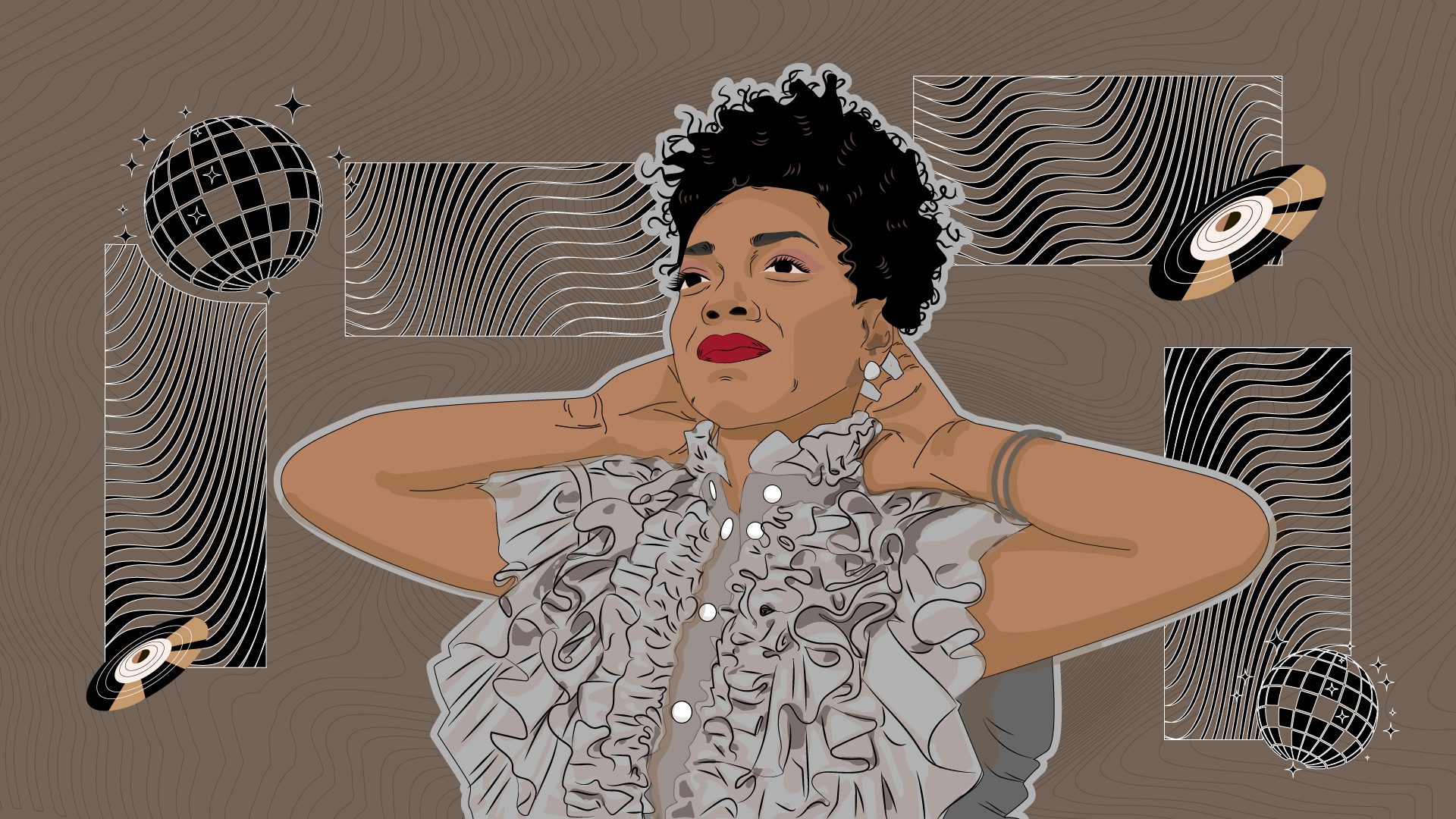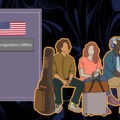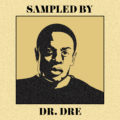BLK PRL is by no means a newcomer to your ears. “I’ve been in this business for over 35 years, and I feel like I’ve lived several lives as Sandy Duperval,” the artist starts by telling us.
Sandy Duperval, vocalist and DJ, first sang in church from a very early age, before pursuing her studies in jazz music. In 2004, she made her public debut on Star Académie, when she was just 20 years old. Over the following decades, she established herself behind the decks as well as on the microphone, and is now deciding to start anew. “The making-of BLK PRL is Sandy Duperval,” says the producer, as we caught up with her in her Montreal studio. Behind this new name, we now discover an accomplished artist who does what she wants, with nothing to stop her. “I’ve wanted to make house music for a long time, something soulful, but truly for the dancefloor. I wanted to go back to the original spark that made me a DJ in the first place. Through BLK PRL, I’m allowing myself to be 100% what I’ve become,” says the producer.
A DJ with a voice
For Sandy Duperval, becoming a DJ was not at all in the cards. When she was in high school, breakdancing was all the rage. “During our rehearsals, my friend would bring his turntables and vinyl records. I asked him if I could have a go, and it just clicked,” she recalls. Later, when she was studying music at CEGEP, her mother put her in touch with the owner of a club, who offered her to try out mixing. “He said, ‘I don’t have a big budget, but you can come and play your vinyls after school, practice, and you’ll open my nights.’ I loved it,” she remembers. Sandy developed an ear, a sound, and a style without considering the profession. During her stint on Star Académie, her talent for DJing was showcased as well. The phone started ringing immediately. “I feel like I’ve been thrown into the lion’s den because I didn’t have enough experience to do long performances, but I had a good musical selection,” she laughs.
It was on the job that she gained the necessary experience. Five years ago, Sandy met a fan who pointed out how much she had improved. “I thanked her for her straightforwardness. From that moment on,” she recounts, “I knew that DJing was going to be part of my life on a bigger scale than I’d thought.”. Then a DJ for almost a decade, Sandy had stopped singing. “My relationship with singing was bittersweet. Being a DJ protected me, and kept me connected to music,” she confides. While mixing at an F1 event, Sandy spontaneously began to sing along to a Bob Sinclar song. “People stopped and started singing with me. I could see that it was something that caught people’s attention,” the producer remembers.
She has since rediscovered her voice and found her calling. “When artists share their art, they also share their vulnerability. It’s not all pretty, we make art out of our pain. I was sick of singing. For the love of singing, I had to stop,” she admits.The singer and DJ felt discouraged by the ruthlessness of the industry. “We’re in an industry that’s run like a corporation. It puts roadblocks in the path of the artist, who needs to be free. The industry doesn’t really appreciate that kind of freedom,” she believes.
Sandy has since been able to let go and start afresh. She doesn’t see her hiatus as a bad thing. “Sometimes you have to let life rock you to see things you wouldn’t have discovered otherwise. There have been accidents along the way that have defined my life, and I wouldn’t change a thing.”
Making yourself at home
House music is a genre style that emerged from disco. “At the beginning, DJs used to loop disco records. It was very musical,” explains Sandy. It’s hard to believe that the artist stumbled upon this music by chance. Although she didn’t know who it was at the time, a friend invited her to see David Morales, who was performing at Stereo, in Montreal. The young singer was charmed by the vibe in the legendary club. It all hit home when she heard the song Most Precious Love, by Barbara Tucker. “It’s a choir, it’s like a spiritual experience. I was familiar with that,” details the artist, who had sung in church for many years.
The other thing that appealed to her was the social aspect. “When we arrived at Stereo, there were all kinds of people. Everyone was smiling, sober or not. Everyone was welcome, it was come as you are” she describes. Though everybody’s realities may differ, unity reigns on the dancefloor. “That’s what house music was for me: a refuge,” says the queer artist, who had not come out at the time but didn’t feel the need to be anyone else. The diversity and the freedom unique to house music captivated her. Sandy now knows that that is what she wants to do. “House music is really for everyone. Once I’d found the musical style that brought people together, I knew it was going to carry my message,” says Sandy.
House music is extremely versatile, ranging from afrohouse to deep house, underground, and a wide variety of sub-genres. It is also a genre that has influenced many other musical styles, particularly ones emerging from black culture. “House music came from Chicago, Detroit and New York. It was black people and Latinos who brought the style to the club scene,” delineates the singer. Over time, the popularity of the genre led to its eventual flattening. “The style, which was created by people of color, ended up being ‘whitewashed.’ We’ve removed the soulful elements – that were initially Black, and came from American culture – to make it more European. We’re creating a scene that has less and less diversity when the style actually emerges from diversity,” laments the DJ.
While the house scene has changed a lot over the past 20 years, it continues to flourish in the metropolis, in all its diversity. “In Montreal,” Sandy mentions, “various styles coexist, there’s a bit of everything for everyone. We’re very lucky not to be caught up in trends.” We are currently seeing a resurgence generated by Beyoncé’s album Renaissance, and Drake’s Honestly, Nevermind. “Internationally, it’s brought about a revival, a renewed public interest. On the Renaissance album, you find the contribution of many underground producers who have continued to stir up the scene. That’s why we feel it’s not just an album that copies a style, but one that pays homage to the house scene,” Sandy goes on to say.
In-house production
Two decades earlier, at a time when she had just begun to study music, Sandy was already thinking of producing music for films and advertising. “My biggest inspiration is Quincy Jones. Before he became a successful producer, he wrote music for films. That was the direction I wanted to go in,” recounts the artist. While today she lends her talent and voice to video games, film music, and remixes, the path to production has turned out more difficult than expected – because she is a black woman. “In the end, it took a long time before I started getting production requests, and to find people who opened the door for me,” confides Sandy.
Fortunately, the producer benefited from the support of extraordinary mentors – mostly white men. They were the ones who kept her going. “I thought there would be a lot of people like them in the industry, but unfortunately not,” says Sandy. She points out an important nuance: not everything is black and white. “The system was created to benefit one group over another. Thankfully, there are people in the business who don’t have that mentality, who want to share their knowledge. They’re harder to find, because there are still so many barriers, and people in positions to create those barriers,” she believes. It was these open-minded professionals who propelled the artist forward, helping her to gain confidence, offering her tools. “They took the time to make me feel like I belonged,” the DJ shares. “When we join forces, we can change things.”
That’s what the singer wants to do with BLK PRL: “Break down these barriers to rebuild bridges, to be less afraid of mixing together, to make music together despite the system in which we’re trying to evolve.”
The adventure begins with a new single to be released, Breathe. The song carries great significance for the artist, who, in a sense, is starting from scratch to establish herself on the market. “I wanted to start with the very essence of who I am, with vulnerability, tenderness,” says the artist, who has long suffered from anxiety. “The important thing is to start by breathing, and the rest will follow. This song is a tool for me, and I hope to be able to share it with others.”
Written by Christelle Saint-Julien
Illustration by Holly Li






















